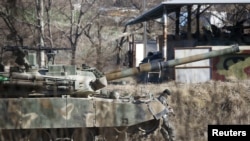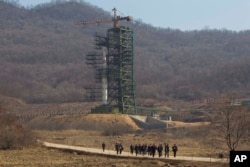U.S. and South Korean military forces on the Korean peninsula have been put on high alert following North Korea’s fourth nuclear test conducted Wednesday.
The U.S Air Force reportedly sent an atmospheric collection aircraft from the Kadena Air Base in Okinawa to gather residue radioactive particles produced by the North Korean blast to determine if it was, as Pyongyang claims, the result of a hydrogen bomb.
Washington and Seoul are skeptical that Pyongyang has advanced its nuclear development program to produce a thermonuclear hydrogen bomb, which is significantly more powerful than the three atomic bombs it tested in the past.
South Korea Defense Minister Han Min-koo and U.S. Defense Secretary Ashton Carter Thursday discussed response measures the Korea-U.S. military alliance is considering, in addition to continued joint exercises.
“Both ministers agreed that North Korea needs to pay price for its provocation,” Han Min-koo said.
Growing nuclear arsenal
North Korea is believed to have enough plutonium to make eight to 12 nuclear weapons, which many security analysts say is more than enough to deter any perceived threat of invasion from the United States or South Korea.
Even if this fourth nuclear test turns out to be less powerful than a Hydrogen bomb, it seems to indicate that North Korea’s nuclear development program in the last few years have shifted from a defensive stance to a more offensive military strategy.
Pyongyang reportedly restarted a uranium enrichment plant last year to produce more nuclear weapons fuel.
The Washington-based Institute for Science and International Security estimates that North Korea could increase its nuclear arsenal to between 20 and 100 weapons by 2020.
This week’s nuclear test followed reports of a failed North Korean submarine-launched ballistic missile (SLBM) test earlier this month. If developed, this capability would give Pyongyang the ability to strike anywhere in the world, including the United States.
Last year U.S. military authorities said they believe North Korea has the ability to miniaturize a nuclear warhead to fit on a KN-08 long range missile, although North Korea has not yet demonstrated this capability.
And North Korea continues to develop its long-range missile technology. It is believed to have 1,000 Soviet model missiles that can reach targets in South Korea and Japan.
“These aren’t really so much for retaliation or defense anymore. These are kind of like society breaking weapons. If you drop a hydrogen bomb in Seoul or a couple on South Korea’s big cities, you’re not going to just kill a lot of people, you are also threatening the ability of South Korea to continue to function as a state,” said North Korea analyst Robert Kelly with Pusan National University.
Military options
On the military side the United States and South Korea must try to strike a balance between acting to contain and deter and provoking a wider conflict.
After North Korea last tested a nuclear device in 2013, Washington sent a pair of nuclear-capable B-2 stealth bombers on a sortie over South Korea in a show of force.
South Korean defense officials have emphasized its plan to build up its short-range missile defenses including the Korean Air and Missile Defense (KAMD) and Kill Chain systems.
Some lawmakers in Seoul are calling for South Korea to develop its own nuclear weapons to counter the growing nuclear threat from the North.
"Against North Korea's nuclear power, I judge that we reached the time to possess peaceful nuclear power for self-defense. Nobody can protect our security,” said Won Yoo-chul, a member of South Korea’s parliament and of the ruling Saenuri party.
Seoul’s defense minister however quickly rejected any possibly of stationing nuclear weapons in South Korea.
There have also been renewed calls in Seoul to set up a U.S. Terminal High Altitude Area Defense [THAAD] system. Beijing reportedly opposes the THAAD deployment in the region that could potentially be used to intercept Chinese missiles.
“I would like to see South Korea start taking THAAD more seriously. I would like to see the Americans and South Koreans and Japanese start really working seriously on regional missile defense. But you know if we don’t go down that route and diplomacy doesn’t seem to be working. My sense is you will see people starting to call for airstrikes,” said North Korea analyst Robert Kelly.
Officials in Seoul Thursday said Pyongyang had two motives for conducting the nuclear test. Externally it wanted to coerce the international community into accepting North Korea as a nuclear power.
It is also a demonstration of strength by the young North Korean leader to solidify his power domestically in advance of a major party conference later this year.
“Internally, we view that North Korea is trying to use it as Kim Jong Un's accomplishment by showing off outcomes of the dual policy ahead of the 7th party conference,” said South Korea foreign ministry spokesman Cho June-hyuck at a briefing Thursday.
Politically, North Korea’s nuclear test brought worldwide condemnation, even from key ally and economic supporter China, and momentum in the United Nations to increase economic and diplomatic sanctions on the isolated and authoritarian Kim Jong Un regime.
Youmi Kim in Seoul contributed to this report.














